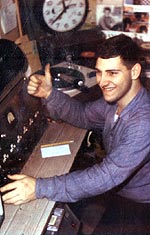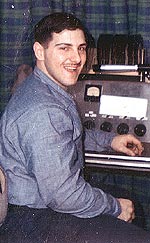The Matt Spero Collection

Matt in KTTY Control Room 
Matt in KTTY Production Room 
Matt Spero Today |
Matt Spero first discovered Radio as a teenager when he peddled his bike down to the local radio station transmitter and studio — KSRO in Santa Rosa, California. The DJ showed him around and even let him play in the Production studio. He was hooked.
Shortly after that visit, Matt built his own little studio in a corner of his parents' garage and would do shows on tape. He even broadcast a few blocks with a very small AM transmitter. 
Matt at AFRTS It was about this time he started to record a few airchecks, picking up stations like KFRC and KYA in San Francisco and KEWB in Oakland. When he entered the Navy in 1965, he was stationed in San Diego and made friends with the Program Director at KCBQ, where they adopted KTTY on board the carrier USS Kitty Hawk as a sister radio station. He worked in Special Services at both the Radio & TV stations. As Tom Post, he had the morning shift from 9 to 12 on KTTY Radio, broadcasting to the crew of over 5000. When Matt got out of the Navy, he worked at KDAC in Fort Brag, CA and eventually moved down to Los Angeles to refine his craft at the Don Martin School of Broadcasting. He then worked at KKDJ Los Angeles, where he was an engineer. As much as he loved working in Radio, he decided that he wanted to settle down in LA. So, he pursued his second ocupational choice and became a Motion Picture Projectionist. These days, Matt does freelance work in video editing and audio production. All through the years he recorded various radio airchecks, and he is glad to be able to share some of them here. The Repository thanks Matt Spero for sharing! |
Unscoped

Scoped

Unscoped
Scoped
Scoped
Unscoped
Unscoped
This is Part Two of a Three Part presentation of The Birth Of A Radio Station – KPLS, Santa Rosa, California, the newest addition to the Polaris Broadcasting group. This historic event started on Sunday, April 19, 1964 at 12Noon – this segment continues immediately following Part One.
The special congratulatory and welcoming messages continue in this segment, which features Swinging Gentlemen Bruce Allen, Pete Gross, Phil Dark and Paul Stewart.
And, you will hear the FIRST commercial announcement of the new station – It’s a Ford dealer selling the new Mustang. Anyone want one of those?
Scoped
This is Part Two of a Three Part presentation of The Birth Of A Radio Station – KPLS, Santa Rosa, California, the newest addition to the Polaris Broadcasting group. This historic event started on Sunday, April 19, 1964 at 12Noon – this segment continues immediately following Part One.
The special congratulatory and welcoming messages continue in this segment, which features Swinging Gentlemen Bruce Allen, Pete Gross, Phil Dark and Paul Stewart.
And, you will hear the FIRST commercial announcement of the new station – It’s a Ford dealer selling the new Mustang. Anyone want one of those?


